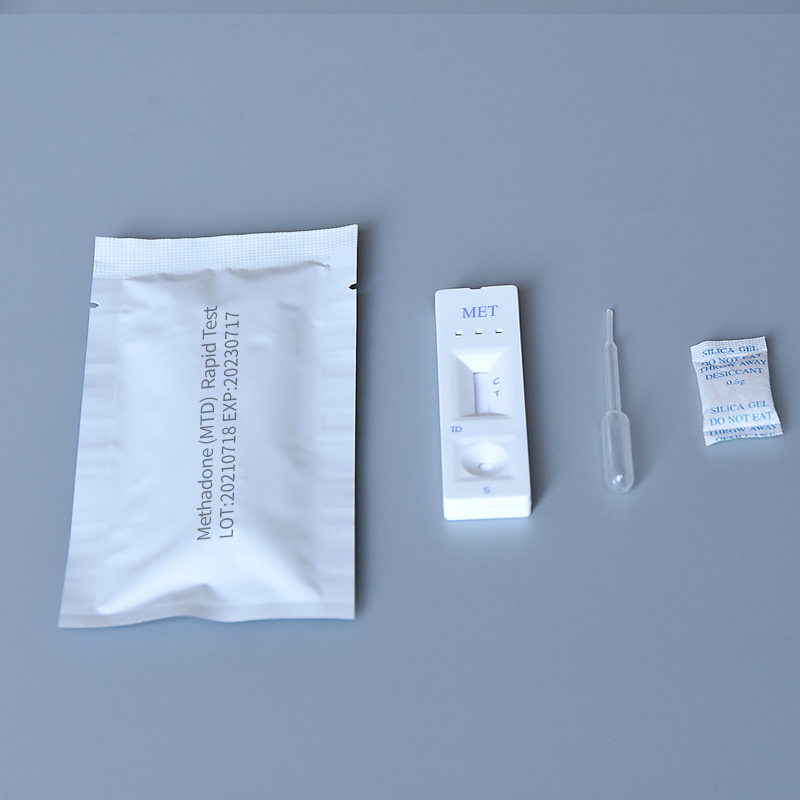Oct . 28, 2025 11:10 Back to list
Methamphetamine (MET) Rapid Test Kit | Fast, Accurate, CE
Field Notes on a Reliable Screen: Methamphetamine (met) Rapid Test Kit
I’ve watched point-of-care drug testing evolve from faint bands on paper to connected readers that log every result. This kit sits in that sweet spot: quick, reader-based, and—crucially—repeatable. In fact, many customers say the routine becomes second nature after a week on the bench.

What it is and how it works
The Methamphetamine (met) Rapid Test Kit is a lateral-flow immunoassay (LFIA) designed for use with an LF Reader. It uses a methamphetamine-specific monoclonal antibody on a nitrocellulose membrane with colloidal gold conjugate. Urine is the routine specimen; the reader interprets the line intensity, reducing subjectivity (goodbye, “is that a line?” debates).
Key specifications (typical configuration)
| Format | Lateral flow cassette, LF Reader required |
| Target / Class | Methamphetamine (MET), amphetamine-class screening |
| Specimen | Human urine |
| Screening cutoff | ≈500 ng/mL (others around 1000 ng/mL on request; real-world use may vary) |
| Assay time | 5 minutes; reader window 5–10 minutes |
| Shelf life | ≈24 months at 2–30°C (sealed, dry) |
| Materials | Nitrocellulose membrane, monoclonal antibody, gold conjugate, sample/absorbent pads, cassette |
| Compliance | Manufacturing under ISO 13485 QMS; alignment to SAMHSA initial-test concepts and CLSI EP12 for qualitative methods |
| Packaging | Individually pouched; common counts 25 tests/kit |

Process flow and real-world use
- Collect urine (chain-of-custody if required).
- Open pouch, place cassette, add drops as directed.
- Start LF Reader; device times, captures, and stores the result.
- Near-cutoff screens should be confirmed by GC/MS or LC-MS/MS—standard practice, to be honest.
Release testing typically challenges 0, 50%, 75%, 100%, 125% and 150% of cutoff; acceptance aims for correct classification near ±25% of cutoff and high overall agreement, per CLSI EP12 guidance. Service life is designed for routine clinics, rehab centers, workplace programs, and corrections—places that need speed without losing traceability.
Industry trends, advantages, and customization
Trend-wise, connectivity is winning: reader outputs integrate with LIMS/EMR, which reduces transcription errors (surprisingly common). Advantages of the Methamphetamine (met) Rapid Test Kit include short assay time, objective reading, and flexible cutoff choices. OEM options: private label, language packs, custom packaging, and multi-panel layouts.

Vendor snapshot (indicative)
| Feature | PrisesBio MET (Reader) | Vendor A (Strip-only) | Vendor B (Cup-based) |
|---|---|---|---|
| Reader compatibility | LF Reader (semi-quant, data log) | Visual only | Some cups, optional reader |
| Cutoff options | ≈500, ≈1000 ng/mL | Usually 1000 ng/mL | Fixed by model |
| Data capture | Onboard memory; export | None | Variable |
| Customization | OEM/branding, languages | Limited | Moderate |
| Certifications | ISO 13485 factory; CE IVD (market-dependent) | Varies | Varies |
Use cases and feedback
- Workplace screening: fast triage with reader printouts for audits.
- Rehab/clinical: consistent near-cutoff behavior; easy operator training.
- Corrections and probation: portability and quick turnaround.
“Reader logging cut our paperwork time by half,” a clinic manager told me. Another buyer liked the straightforward training: “New staff were testing accurately by day two.” To be honest, that aligns with what I’ve seen.

Standards, testing, and notes
Initial screens commonly align with SAMHSA amphetamine-class guidance around 500 ng/mL; positives should be confirmed by GC/MS or LC-MS/MS. Qualitative performance is typically evaluated under CLSI EP12 principles. Manufacturing under ISO 13485 QMS and EU IVD requirements is standard among exporters in Hebei (Origin: No.136, Shiji West Road, Gaobeidian City, 074000, Hebei Province, P.R. China). Always verify local regulatory status.
Case snapshots
A regional logistics firm deployed the Methamphetamine (met) Rapid Test Kit with an LF Reader across three depots; result exports fed directly to their HR system—fewer transcription errors, smoother audits. In a community clinic, near-cutoff samples flagged by the reader were reflexed to LC-MS/MS, tightening their false-positive risk management.
References
- HHS/SAMHSA. Mandatory Guidelines for Federal Workplace Drug Testing Programs (Urine), 2017 (and updates). https://www.samhsa.gov/workplace/drug-testing
- CLSI. EP12: User Protocol for Evaluation of Qualitative Test Performance. https://clsi.org
- ISO 13485:2016 Medical devices—Quality management systems. https://www.iso.org/standard/59752.html
- EU Regulation (EU) 2017/746 on in vitro diagnostic medical devices (IVDR). https://health.ec.europa.eu
-
Comprehensive Guide to Syphilis Test Types: Methods, Uses, and Innovations
NewsNov.24,2025
-
Syphilis Test Strips: Affordable & Rapid Diagnostics for Global Health
NewsNov.24,2025
-
Syphilis Quick Test: Rapid Diagnosis to Improve Global Health Outcomes
NewsNov.23,2025
-
Comprehensive Guide to Syphilis Test Price: Costs, Trends, and Global Impact
NewsNov.23,2025
-
Comprehensive Guide to Syphilis Test Malaysia – Accurate, Accessible & Affordable
NewsNov.22,2025
-
Comprehensive Guide to Lab Tests for Syphilis: Global Importance and Innovations
NewsNov.22,2025

